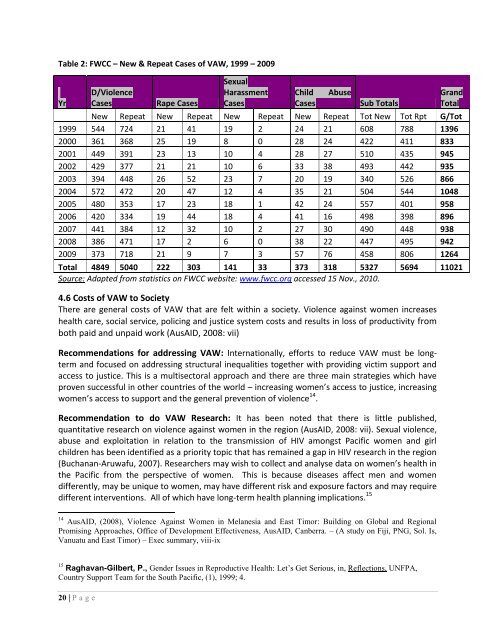Project Report â Fiji 2010 - Pacific Health Voices
Project Report â Fiji 2010 - Pacific Health Voices
Project Report â Fiji 2010 - Pacific Health Voices
Create successful ePaper yourself
Turn your PDF publications into a flip-book with our unique Google optimized e-Paper software.
Table 2: FWCC – New & Repeat Cases of VAW, 1999 – 2009<br />
Yr<br />
D/Violence<br />
Cases<br />
Rape Cases<br />
Sexual<br />
Harassment<br />
Cases<br />
Child<br />
Cases<br />
Abuse<br />
Sub Totals<br />
Total 4849 5040 222 303 141 33 373 318 5327 5694 11021<br />
Source: Adapted from statistics on FWCC website: www.fwcc.org accessed 15 Nov., <strong>2010</strong>.<br />
4.6 Costs of VAW to Society<br />
There are general costs of VAW that are felt within a society. Violence against women increases<br />
health care, social service, policing and justice system costs and results in loss of productivity from<br />
both paid and unpaid work (AusAID, 2008: vii)<br />
Recommendations for addressing VAW: Internationally, efforts to reduce VAW must be longterm<br />
and focused on addressing structural inequalities together with providing victim support and<br />
access to justice. This is a multisectoral approach and there are three main strategies which have<br />
proven successful in other countries of the world – increasing women’s access to justice, increasing<br />
women’s access to support and the general prevention of violence 14 .<br />
Recommendation to do VAW Research: It has been noted that there is little published,<br />
quantitative research on violence against women in the region (AusAID, 2008: vii). Sexual violence,<br />
abuse and exploitation in relation to the transmission of HIV amongst <strong>Pacific</strong> women and girl<br />
children has been identified as a priority topic that has remained a gap in HIV research in the region<br />
(Buchanan-Aruwafu, 2007). Researchers may wish to collect and analyse data on women’s health in<br />
the <strong>Pacific</strong> from the perspective of women. This is because diseases affect men and women<br />
differently, may be unique to women, may have different risk and exposure factors and may require<br />
different interventions. All of which have long-term health planning implications. 15<br />
Grand<br />
Total<br />
New Repeat New Repeat New Repeat New Repeat Tot New Tot Rpt G/Tot<br />
1999 544 724 21 41 19 2 24 21 608 788 1396<br />
2000 361 368 25 19 8 0 28 24 422 411 833<br />
2001 449 391 23 13 10 4 28 27 510 435 945<br />
2002 429 377 21 21 10 6 33 38 493 442 935<br />
2003 394 448 26 52 23 7 20 19 340 526 866<br />
2004 572 472 20 47 12 4 35 21 504 544 1048<br />
2005 480 353 17 23 18 1 42 24 557 401 958<br />
2006 420 334 19 44 18 4 41 16 498 398 896<br />
2007 441 384 12 32 10 2 27 30 490 448 938<br />
2008 386 471 17 2 6 0 38 22 447 495 942<br />
2009 373 718 21 9 7 3 57 76 458 806 1264<br />
14 AusAID, (2008), Violence Against Women in Melanesia and East Timor: Building on Global and Regional<br />
Promising Approaches, Office of Development Effectiveness, AusAID, Canberra. – (A study on <strong>Fiji</strong>, PNG, Sol. Is,<br />
Vanuatu and East Timor) – Exec summary, viii-ix<br />
15 Raghavan-Gilbert, P., Gender Issues in Reproductive <strong>Health</strong>: Let’s Get Serious, in, Reflections, UNFPA,<br />
Country Support Team for the South <strong>Pacific</strong>, (1), 1999; 4.<br />
20 | P a g e
















